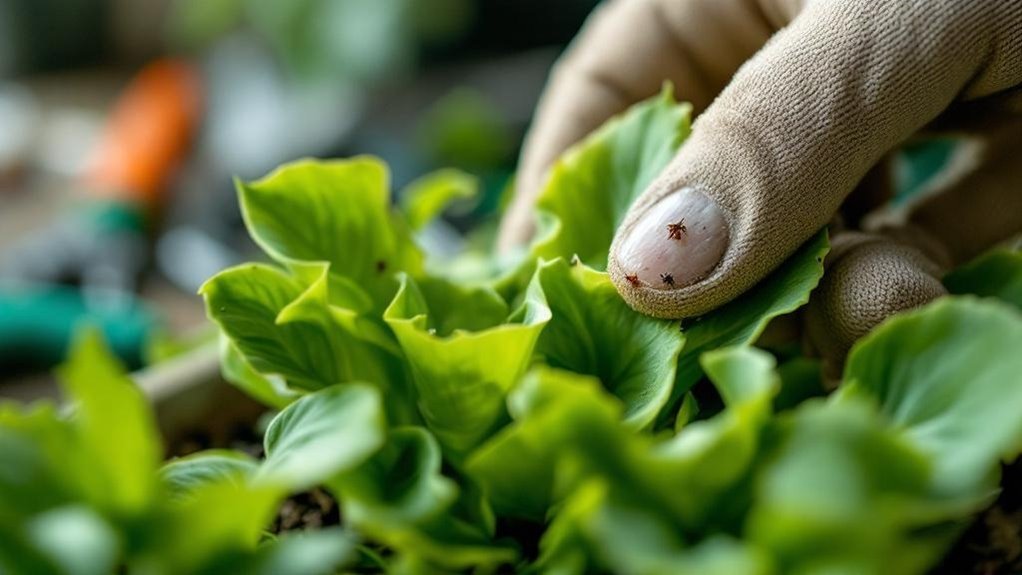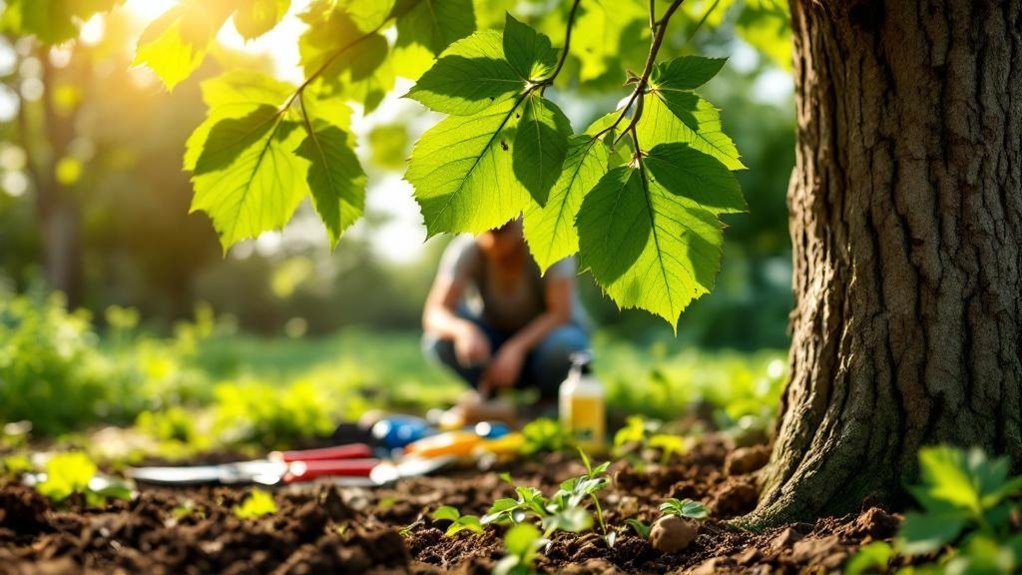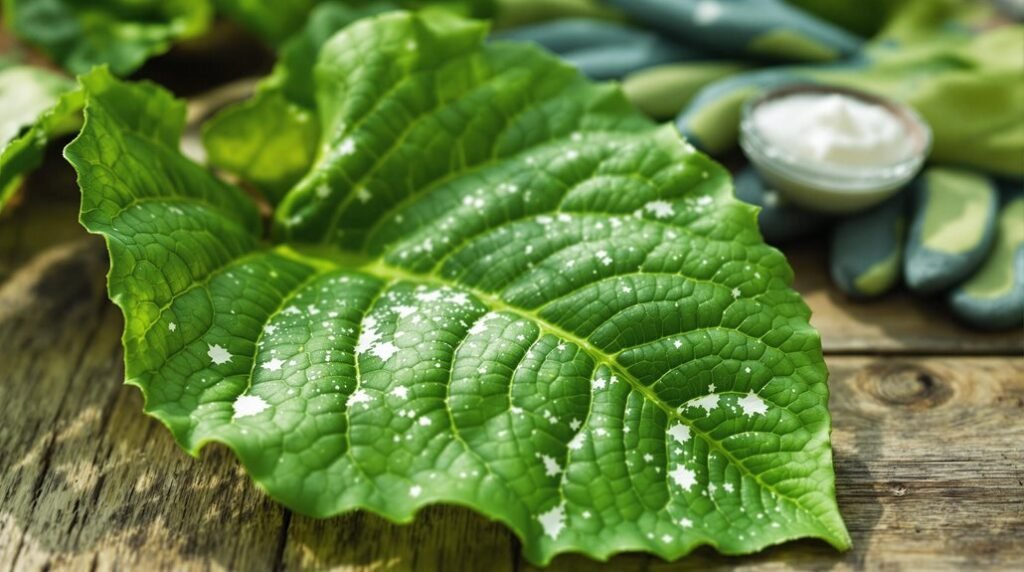You might not realize that the common leaf curl affecting your plants often starts long before symptoms appear, triggered by specific fungal spores during cool, wet seasons. If left unchecked, this issue can severely reduce fruit quality and overall plant health. Understanding what causes leaf curl and how to effectively manage it could make all the difference in your garden’s success. Let’s explore what you need to know to keep your plants thriving.
Understanding Leaf Curl and Its Impact
Although leaf curl might seem like a minor issue, it can greatly harm your stone fruit trees by causing distorted, puckered leaves and premature leaf drop.
When young leaves become infected by the Taphrina deformans fungus, they swell and twist, turning pinkish and losing their normal shape. These infected leaves eventually fall off early, weakening your tree’s ability to photosynthesize and grow.
Infected young leaves swell, twist, and turn pink, leading to early drop and reduced tree growth.
If you notice these symptoms, it means the fungus has already taken hold during the essential early growth stage. Since the fungus survives dormant on branches through winter, it targets your young leaves as they emerge in spring.
Recognizing this impact helps you understand why timely care and intervention are vital to protect your tree’s health and prevent ongoing damage.
Identifying Common Causes of Leaf Curl
Recognizing the effects of leaf curl is just the first step in protecting your trees and plants. To identify common causes, look at infected leaves for signs of the fungal disease Taphrina deformans, which distorts stone fruit leaves.
Environmental stressors like heat, drought, and uneven watering often trigger leaf curl in tomatoes and other plants by stressing them. Nutrient deficiencies, especially low nitrogen, phosphorus, or potassium, can also cause leaves to curl as plants prioritize new growth.
Additionally, pests such as aphids and spider mites suck sap, leading to wilting and curling. Regularly checking your plants helps you pinpoint the exact cause of leaf curl, so you can apply the right treatment or adjust care practices promptly to keep your garden healthy.
Recognizing Symptoms on Affected Plants

When you spot distorted, puckered leaves with a bronzed or reddish tint on your peach, nectarine, or apricot trees, it’s a clear sign of leaf curl caused by the fungus Taphrina deformans.
Infected leaves often appear thickened and curled, disrupting the plants ability to photosynthesize effectively. You might also notice these infected leaves dropping prematurely, which weakens the tree and reduces fruit yield.
Keep an eye out for early fruit and flower drop, as this signals a severe infection that threatens the plant’s overall health. Recognizing these symptoms early helps you act quickly to protect your trees and prevent the disease from spreading further.
Organic Treatment Options for Leaf Curl
To effectively manage leaf curl organically, you should apply copper-based fungicides like copper hydroxide or copper oxychloride at the bud-swell stage, ensuring thorough coverage of all branches.
These organic treatments help prevent fungal infections that cause curling leaves on your plants. Remove infected leaves promptly and clear fallen ones around trees to reduce reinfection risk.
Using open-sided tents over garden bushes in early spring can also shield plants from fungal spores.
Mulching with garden compost and maintaining proper watering boost your plants’ health and resilience against leaf curl.
Additionally, regular applications of eco-seaweed and eco-aminogro support overall tree vigor, helping your plants recover from and resist curling leaves more effectively.
These combined organic treatments provide a natural approach to managing leaf curl.
Preventative Measures to Protect Trees

Alongside organic treatments, taking preventative measures can greatly reduce the chances of leaf curl affecting your trees. Apply barrier sprays like copper hydroxide before bud-swell, remove fallen leaves promptly, and avoid excess water to prevent fungal growth. Supporting new growth through proper watering, fertilization, and pruning keeps your tree healthy and resilient.
| Preventative Measure | When to Apply | Purpose |
|---|---|---|
| Copper barrier spray | Before bud-swell | Prevent fungal infection |
| Leaf removal | Regularly | Minimize reinfection risk |
| Water management | Ongoing | Avoid excess water |
| Pruning and fertilizing | Growing season | Support new growth |
| Covering in winter | Winter months | Protect from harsh weather |
These steps will help you maintain vigorous, disease-resistant trees year-round.
Caring for Trees During and After Infection
Although leaf curl can severely impact your tree’s health, you can manage the infection effectively by closely monitoring symptoms and providing targeted care.
For infected trees, consistently check for new signs of infection and promptly remove affected leaves and fallen debris to minimize spore spread.
Support tree recovery by applying organic treatments and ensuring proper nutrition through balanced fertilization and adequate watering.
Mulching with garden compost helps maintain soil moisture and boosts resilience.
These steps reduce stress on your tree, aiding its defense against the fungal pathogen.
Remember, maintaining tree vigor with these practices is key to helping infected trees recover and prepare for healthier future growth.
Integrating Pest Management With Leaf Curl Control
When you integrate pest management with leaf curl control, you tackle one of the key factors that weaken your trees and make them more vulnerable to the disease.
Pests like aphids and spider mites stress your plants, allowing the fungus to survive and infect new leaves more easily. Regularly inspect your trees and use organic treatments such as neem oil or insecticidal soap to control pests without harming beneficial insects.
Strengthen your trees with proper watering and fertilization to boost resilience. Combining physical barriers like row covers with biological controls, such as introducing beneficial insects, creates an effective integrated pest management approach.
This thorough strategy reduces pest populations, limits fungal survival, and helps keep your trees healthy, preventing leaf curl from taking hold in new growth.
Frequently Asked Questions
How Do You Fix Curling Leaves on Plants?
You fix curling leaves by adjusting watering, ensuring proper nutrients, and reducing heat stress. Check for pests regularly and treat them promptly. Applying organic fungicides early helps prevent diseases. Always monitor your plant’s environment closely.
How to Fix Leaf Curl Disease?
You protect your trees by spraying copper at bud-swell, removing infected leaves, and caring for tree health. You prevent the disease early, treat in late winter if needed, and maintain vigor to fix leaf curl effectively.
Can Curled Leaves Go Back to Normal?
Yes, curled leaves can go back to normal if you address causes like watering issues or nutrient deficiencies quickly. However, if the curl results from severe diseases, you’ll need to remove affected leaves to protect your plant.
What to Spray on Tomatoes for Leaf Curl?
You should spray Safer® Brand Neem Oil on your tomatoes to control pests causing leaf curl. Make sure to cover all foliage thoroughly and monitor environmental stress to keep your plants healthy and resilient.
Final Thoughts
You might think managing leaf curl is too complicated or time-consuming, but with simple organic treatments and preventative steps, you can keep your plants healthy without hassle. By applying copper-based fungicides early, removing infected leaves, and monitoring pests regularly, you’ll protect your trees effectively. Don’t wait for damage to take over—start caring for your plants now, and you’ll enjoy healthier leaves and better yields all season long.
